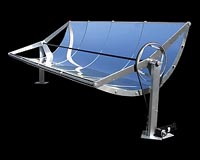 |
Houston TX (SPX) Jan 19, 2010 New experiments on a recently discovered class of iron-based superconductors suggest that the ability of their electrons to conduct electricity without resistance is directly connected with the magnetic properties of those electrons. Results of the experiments appear in Physical Review Letters. The tests, which were carried out by a team of U.S. and Chinese physicists, shed light on the fundamental nature of high-temperature superconductivity, said Rice physicist Qimiao Si, a co-author on the study. If better understood, high-temperature superconductors could be used to revolutionize electric generators, MRI scanners, high-speed trains and other devices. In the study, scientists from Rice University, the University of Tennessee, Oak Ridge National Laboratory (ORNL), the National Institute of Standards and Technology (NIST), the Chinese Academy of Sciences' Institute of Physics and Renmin University in Beijing examined several iron-arsenide compounds. These are the "undoped" parents of the iron "pnictides" (pronounced: NICK-tides), a class of materials that were found to be high-temperature superconductors in 2008. The experiments set out to test theoretical predictions that Si and collaborators published in the Proceedings of the National Academy of Sciences last March. They predicted that varying the size of some atoms in the parent compounds could allow physicists to tune the material's quantum fluctuations. These types of fluctuations can create tipping points called magnetic "quantum critical points," a state that exists when a material is at the cusp of transitioning from one quantum phase to another. Using neutron-scattering facilities at NIST and ORNL, the team bombarded the materials with neutrons to decipher their structural and magnetic properties. The tests, which supported Si's theoretical predictions, determined that the strength of magnetic order in the materials was reduced when arsenic atoms were replaced with slightly smaller phosphorus atoms. "We found the first direct evidence that a magnetic quantum critical point exists in these materials," Si said. The results were made possible by the efforts of Nanlin Wang, a physicist from the Chinese Academy of Sciences' Institute of Physics, and his research group. They created a series of samples with varying amounts of phosphorous substituting for arsenic. The discovery of high-temperature superconductivity in copper-oxide ceramics in 1986 led physicists to realize that quantum effects in electronic materials were far more complex than anticipated. One of these effects is quantum criticality. Criticality occurs near a tipping point that a material goes through when it changes phases. Many phase changes - like ice melting into water - occur because of thermal fluctuations. But quantum criticalities and quantum phase changes arise solely from quantum fluctuations. "Our finding of a quantum critical point in iron pnictides opens the door for new avenues of research into this important class of materials," said University of Tennessee/ORNL physicist Pengcheng Dai, a neutron scattering specialist. Si said, "The evidence from this study bolsters the hypothesis that high-temperature superconductivity in the iron pnictides originates from electronic magnetism. This should be contrasted to conventional low-temperature superconductivity, which is caused by ionic vibrations."
Share This Article With Planet Earth
Related Links Rice University Powering The World in the 21st Century at Energy-Daily.com
 World leaders make new call for clean energy commitments
World leaders make new call for clean energy commitmentsAbu Dhabi (AFP) Jan 18, 2010 World leaders raised a fresh alarm on global warming Monday, urging international action to increase use of clean energy at a four-day forum that opened in the oil-rich emirate of Abu Dhabi. "If we don't act now, our coral reefs and rainforests will die, desert countries will become unbearably hot and low lying countries like the Maldives, will slip beneath the rising seas," said the preside ... read more |
|
| The content herein, unless otherwise known to be public domain, are Copyright 1995-2009 - SpaceDaily. AFP and UPI Wire Stories are copyright Agence France-Presse and United Press International. ESA Portal Reports are copyright European Space Agency. All NASA sourced material is public domain. Additional copyrights may apply in whole or part to other bona fide parties. Advertising does not imply endorsement,agreement or approval of any opinions, statements or information provided by SpaceDaily on any Web page published or hosted by SpaceDaily. Privacy Statement |